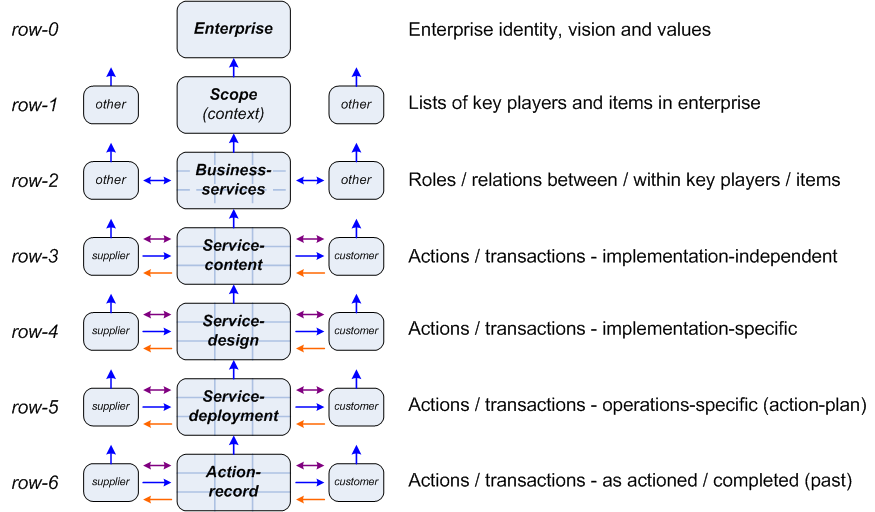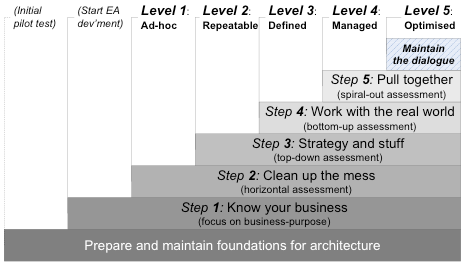The game of enterprise-architecture
Given the parlous state of most current enterprise-architecture ‘education’, is there any way we could do it better?
One option might be to reframe EA-education as a game.
I don’t mean ‘gamification’ as per the asinine ‘boy-scout badges for enterprise-architects’ scheme recently proposed by one wannabe EA association. That’s just blocks of training-content – which, rather than the solution to our problem here, is actually its source. Content-based training only makes sense for contexts that always remain the same and require no actual decisions – almost the exact opposite to what we face in real-world enterprise-architecture.
The key area where most EA-‘education’ fails is in its over-focus on content – when what we should be focusing on is context.
Or, more specifically, focus on how to make sense of any given context – and, from there, then build towards an understanding of appropriate content for that context.
So how could we do that?
What could we build that would actually work for real education in EA?
Seems to me there’s a lot we could learn from current graphic-puzzle games for mobile devices, such as Ustwo’s Monument Valley, or Square Enix’s Lara Croft Go.
Imagine an EA-game in which, like both Monument Valley and Lara Croft Go, there’s no need for a tutorial. Instead, we learn by doing: we prod or swipe across the screen, click on objects, and see what happens. Observe, orient, decide, act.
Imagine an EA-game where we move not only across every part of the context-space, but up and down the levels of detail that we need to move our needed changes from initial idea to real-world implementation, and back again for subsequent review:
Imagine an EA-game that doesn’t arbitrarily over-emphasise IT, or anything else, but instead invites us to explore every aspect of the literal ‘the architecture of the enterprise’ – the overall effectiveness of the enterprise, as a unified whole.
Imagine an EA-game that allows us to apply consistent, contextual metatheory of architecture in a ‘back-door’, hands-on way that makes sense to everyone – to all of our stakeholders.
Imagine an EA-game where the game-levels show us how to work with the different tasks of each EA maturity-level:
Imagine an EA-game where the core task of the game is to explore how to link things together in a purposeful way – how to reach towards the aim of all architecture, that “things work better when they work together, on purpose”.
Imagine an EA-game where the measure of success, the metric on which we ‘win’ or ‘lose’ the game, is the trust of stakeholders, imaginary or real – bringing metaphoric roses, or wielding a sharp-pointed stake in the player’s direction!
Imagine an EA-game that, with a few tweaks and adaptations – more towards Minecraft, perhaps, or Sim City – would also work as a real-world EA-toolset in its own right.
And imagine an EA-game that – unlike most current ‘EA’-frameworks and toolsets – can be used on any device, visually engaging, challenging, a game that people want to play and use.
It’s all doable, right now, via existing cross-platform game-engines such as Unity or Amazon’s Lumberyard.
All it needs is a bit of imagination.
(And, yes, a lot of hard work – but that’s true for everything.)
Interested?
Let’s make it happen!




EA training is just that — vocational task-learning in an established framework. It is that way because it is easier to train people in the content of a framework than in the context of their enterprise. EA training leaves it up to the trainee to make the (notionally simple) bridge from content to their particular context. In fact it is the hardest thing to do. It is where most EA fails (and most strategic planning which suffers from the same content/framework/method fixation). I think there is great promise in using a gaming engine to do enterprise visualisation (as-is) and enterprise target state definition (to-be). I’m probably not the guy to do it. But someone will, and soon.
Wonderful mean to learn about enterprise architecture as an entertainment.
Interesting to contemplate what might be the minimum viable set of rules that should underpin this game!!